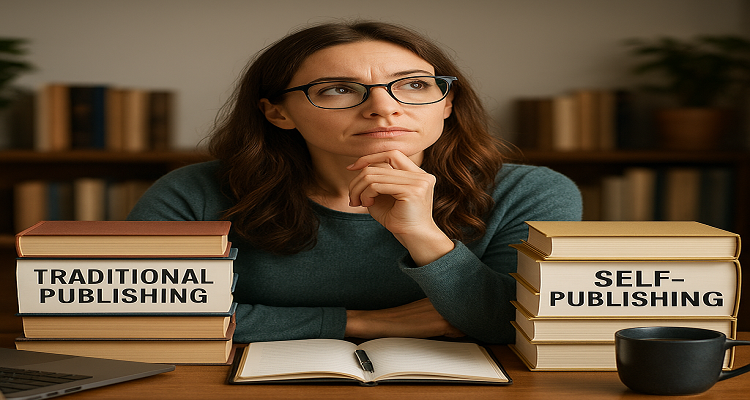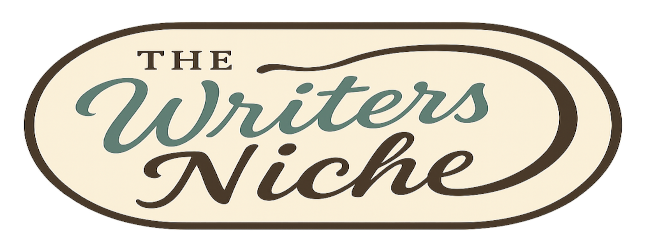
Traditional Publishing vs. Self-Publishing: Which Path Is Right for You?
For many writers, the ultimate dream is holding a published book in their hands. But these days, there’s more than one road to get there and deciding which path is right for you can feel overwhelming.
Should you chase the traditional publishing route, with literary agents, book deals, and a shot at bookstore shelves? Or should you go the self-publishing route, where you control everything but also shoulder all the responsibility?
Here’s the good news: there’s no one-size-fits-all answer. Both paths have their perks, challenges, and opportunities. The key is understanding what each offers and which aligns with your goals, personality, and resources.
In this article, we’ll break it all down: the pros, cons, timelines, royalties, control, marketing realities, and even the exciting middle ground of hybrid publishing. By the end, you’ll have a clear-eyed view of which publishing path is right for you and how to move forward with confidence.
1. Traditional Publishing: The Classic Route
Traditional publishing refers to signing a contract with a publishing house that takes care of editing, design, production, distribution, and often some marketing. This usually involves:
- Querying literary agents.
- Getting an agent to represent you.
- Having the agent pitch your manuscript to publishers.
- Signing a book deal if accepted.
Pros:
✅ Professional editing, design, and production
✅ Access to bookstores, libraries, and major media
✅ Potential for advance payments and royalties
✅ Validation and credibility in the industry
Cons:
❌ Long timelines (often 1–3 years from book deal to bookshelf)
❌ Difficult to break in (many agents receive hundreds of queries per month)
❌ Loss of creative control (publishers may change titles, covers, or content)
❌ Marketing support varies many authors must promote themselves
Who thrives here?
- Writers aiming for prestige, awards, or wide distribution
- Those who are patient with long timelines and open to collaboration
- Writers willing to handle rejections and revise extensively
2. Self-Publishing: The Indie Revolution
Self-publishing means you skip the gatekeepers and publish your book independently through platforms like Amazon KDP, IngramSpark, or Draft2Digital. You hire your own editors and designers or DIY.
Pros:
✅ Total creative control over content, cover, and pricing
✅ Faster timelines (you can publish in months, not years)
✅ Higher royalties (often 70% on ebook sales)
✅ Direct connection with your readers
Cons:
❌ You shoulder all upfront costs (editing, design, marketing)
❌ No automatic access to bookstores or major media
❌ Harder to build credibility without awards or big-name backing
❌ Requires a DIY mindset or the ability to build a professional team
Who thrives here?
- Entrepreneurs, niche experts, or genre fiction authors (especially romance, thriller, or fantasy)
- Writers who love marketing and are business-minded
- Those eager to experiment, iterate, and adapt
3. Key Differences: Timeline, Control, Royalties
Let’s break it down side by side.
|
Category |
Traditional |
Self-Publishing |
|
Timeline |
1–3 years |
3–12 months |
|
Creative Control |
Limited (publisher decides) |
Total control |
|
Costs |
Publisher-funded |
Author-funded |
|
Royalties |
~10–15% (hardcover), ~25% (ebook) |
Up to 70% (ebook), ~40% (print) |
|
Distribution |
Bookstores, libraries, online |
Mostly online (Amazon, etc.) |
4. How to Assess Your Goals and Resources
Here’s where it gets personal.
Ask yourself:
- Do I want to reach a broad, mainstream audience or a niche community?
- Am I willing to wait years or do I want to publish on my timeline?
- Do I want the validation of traditional publishing or the independence of self-publishing?
- What’s my budget for upfront costs like editing, cover design, and marketing?
- Am I comfortable learning marketing or do I prefer to focus on the writing?
There’s no wrong answer just the answer that’s right for you.
5. Hybrid Publishing: The Best of Both Worlds?
Hybrid publishing blends elements of traditional and self-publishing. Some models:
- You pay part of the costs, but the publisher offers editing, design, and distribution.
- Small presses that don’t require agents but offer selective publishing and distribution.
- Partnerships where authors retain more royalties but benefit from a team.
Pros:
✅ Professional support and distribution
✅ More control than traditional publishing
✅ Shared investment and risk
Cons:
❌ Costs can be high research carefully
❌ Not all hybrid publishers are reputable (watch out for scams)
6. Case Studies: Real-World Examples
Traditional:
- J.K. Rowling (Harry Potter) queried agents, landed Bloomsbury.
- Elizabeth Gilbert (Eat Pray Love) published through Penguin.
Self-Publishing:
- Andy Weir (The Martian) self-published online, later picked up by a major publisher.
- Amanda Hocking sold over a million self-published ebooks, became a publishing sensation.
Hybrid:
- Many authors in nonfiction or niche genres use hybrid presses to reach specific audiences with professional support.
7. Tips for Choosing Your Path
✅ If you crave prestige, patience, and wide reach → query agents and aim for traditional.
✅ If you want speed, control, and direct reader connection → go indie.
✅ If you want professional support but still own your project → consider hybrid.
8. How to Get Started
Traditional Path:
- Research literary agents in your genre.
- Write a polished query letter.
- Submit to agents and prepare for revisions.
Self-Publishing Path:
- Hire a professional editor.
- Hire a cover designer (or invest in a pro template).
- Learn the basics of formatting and publishing on Amazon KDP or similar.
- Build a marketing plan (social media, newsletter, ads).
Hybrid Path:
- Research reputable hybrid publishers.
- Request author references.
- Review contracts carefully.
There’s No Wrong Path
Publishing a book is a huge accomplishment no matter how you get there.
What matters most is choosing the path that fits your dreams, timeline, and personality.
If you’re unsure, start small:
- Submit a few short stories or essays to magazines.
- Self-publish a small project like a novella or guide.
- Query a few agents and see what feedback you get.
Remember, today’s publishing world is flexible and many authors move between paths throughout their careers. There’s never been a more exciting time to be a writer.
